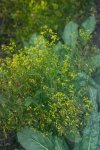Waida dyeing - isatis tinctoria l.
Family Cruciferae - Brassicaceae (Cruciferae)
Botanical characteristics. A biennial herbaceous plant with a height of up to 1 m or more. It grows wild in light oak forests, steppes, on dry hills, along the banks of rivers and lakes, on sandy and calcareous slopes.
Root stem with a small amount of accessory roots. Leaves are one-piece, oblong, cauline narrower, arrow-shaped, gray-green. Flowers yellow, small, collected in a large paniculate inflorescence. Pods oblong, curved, winged, dangling on thin petioles, brown, lower often wingless. Blossoms in May - June, fructifies in July - August.
Spread. Recently vaidu are grown on private plots, in orchards as an ornamental and medicinal plant. With a production purpose - to get indigo paint and as a cosmetic.
Used parts of the plant. For the medicinal purposes, roots, leaves, inflorescences, seeds are collected during the whole vegetation period of the plant, dried in the usual way, but it is best in dryers at a temperature of 30-40 "C, as long as the drying substances decompose. All parts of the plant have medicinal properties.
Chemical composition. The roots contain thioglycosides (containing sulfur): sinigrin. In the aerial part, saponins and a large set of vitamins were found. Leaves and flowers contain indigo dyes: indigotine; Nitrogen compounds, flavonoids. Seeds contain fatty oil, in its composition acids: linoleic, erucic, oleic, linolenic, arachine, palmitic, stearic, eicosadiene, eicosenic, lignoceric; A lot of carbohydrates, alkaloids.
Application. Vaida dye has long been used for cancer. In the experiment, all Waida preparations have antibacterial properties.
The aerial part of the plant in the form of broths and infusions is used in folk medicine for diseases of the spleen, infectious diseases, mainly in measles, as a laxative and vomiting poisoning, including fungi.
In Tibetan medicine, waidu is widely used in various diseases, especially roots (in the form of broths), which have a harmful effect on the intestinal and typhoid bacillus, the causative agent of dysentery, which is confirmed in experiments.
Infusions of the aerial part and decoction of the roots give good results in the treatment of epidemic meningitis, encephalitis, acute hepatitis, mumps. Outer is effective in inflammation of the throat, tumors, boils, wounds, ulcers, dermatomycosis, both inside and outwardly.
Seeds are suitable for obtaining a fatty oil, close in composition to linseed, is its substitute, and in some cases exceeds it.
Fresh juice is obtained from slightly withered leaves and is used as a cosmetic. They dye their eyebrows, eyelashes, eyelids, densely applying every time after a slight drying. This natural dye will relieve the infections of the eyelids and eyes, stimulates the growth of hairs and the density of eyelashes.
From leaves wajda dyeing receives indigo paint.
Due to the fact that the plant accumulates a large amount of sugar (for the entire flowering period up to 75 kg / ha), it is recommended for introduction into the culture, and has already been successfully tested in the entire Non-Chernozem Zone and in Western Siberia.
Preparation
- For broth take 50-60 g of crushed root, pour 250 ml of boiling water, insist on a boiling water bath for 30 minutes, cool 10 minutes, without removing from the bath, filter the warm. Take 3-4 times a day for 1/3 cup, regardless of food intake.
- For infusion of 50 g of leaves or flowers, pour 200 ml of boiling water, insist on a boiling water bath for 15 minutes, cool for 45 minutes, filter. Take 1/3 cup 3 times a day, immediately after a meal or during a meal.
- You can make syrup from flowers. For this, 100 g of flowers are poured with boiling water, insist 15-20 minutes closed. This produces sweet tea. Take also as an infusion.
Contraindications. Due to the high content of carbohydrates in the plant, its use in diabetes requires great care .





Comments
When commenting on, remember that the content and tone of your message can hurt the feelings of real people, show respect and tolerance to your interlocutors even if you do not share their opinion, your behavior in the conditions of freedom of expression and anonymity provided by the Internet, changes Not only virtual, but also the real world. All comments are hidden from the index, spam is controlled.